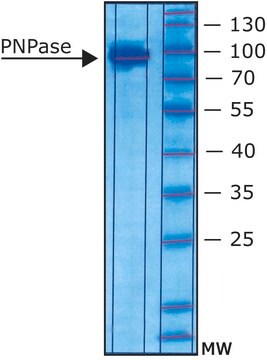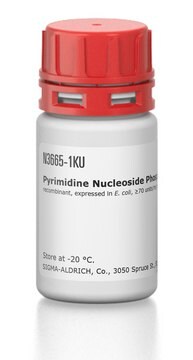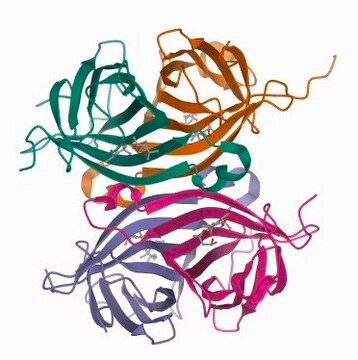N1290
Polynucleotide phosphorylase human
Sinonimo/i:
Polyribonucleotide nucleotidyltransferase
Autenticatiper visualizzare i prezzi riservati alla tua organizzazione & contrattuali
About This Item
Numero MDL:
Codice UNSPSC:
12352204
NACRES:
NA.54
Prodotti consigliati
Ricombinante
expressed in E. coli
Stato
solution
enzyme activity
≥20 units/mg protein
PM
~90 kDa
Concentrazione
400-600 μg/mL protein
Condizioni di spedizione
dry ice
Temperatura di conservazione
−70°C
Azioni biochim/fisiol
Polynucleotide phosphorylase (PNPase) is a bifunctional enzyme with a phosphorolytic 3′ to 5′ exoribonuclease activity and a 3′-terminal oligonucleotide polymerase activity. It is also involved in mRNA processing and degradation in bacteria, plants, and humans.
Stato fisico
supplied as a solution in 20 mM HEPES buffer, pH 7.9, with 0.1 mM EDTA, 2 mM DTT, 12.5 mM MgCl2, ~130 mM KCl, and 20% (w/v) glycerol.
Codice della classe di stoccaggio
12 - Non Combustible Liquids
Classe di pericolosità dell'acqua (WGK)
WGK 1
Punto d’infiammabilità (°F)
Not applicable
Punto d’infiammabilità (°C)
Not applicable
Scegli una delle versioni più recenti:
Certificati d'analisi (COA)
Lot/Batch Number
Non trovi la versione di tuo interesse?
Se hai bisogno di una versione specifica, puoi cercare il certificato tramite il numero di lotto.
Possiedi già questo prodotto?
I documenti relativi ai prodotti acquistati recentemente sono disponibili nell’Archivio dei documenti.
Lukasz S Borowski et al.
Biochimica et biophysica acta, 1797(6-7), 1066-1070 (2010-02-02)
Protein complexes responsible for RNA degradation play important role in three key aspects of RNA metabolism: they control stability of physiologically functional transcripts, remove the unnecessary RNA processing intermediates and destroy aberrantly formed RNAs. In mitochondria the post-transcriptional events seem
Victoria Portnoy et al.
RNA (New York, N.Y.), 14(2), 297-309 (2007-12-18)
PNPase is a major exoribonuclease that plays an important role in the degradation, processing, and polyadenylation of RNA in prokaryotes and organelles. This phosphorolytic processive enzyme uses inorganic phosphate and nucleotide diphosphate for degradation and polymerization activities, respectively. Its structure
Hsiao-Wen Chen et al.
Molecular and cellular biology, 26(22), 8475-8487 (2006-09-13)
We recently identified polynucleotide phosphorylase (PNPase) as a potential binding partner for the TCL1 oncoprotein. Mammalian PNPase exhibits exoribonuclease and poly(A) polymerase activities, and PNPase overexpression inhibits cell growth, induces apoptosis, and stimulates proinflammatory cytokine production. A physiologic connection for
Takashi Nagaike et al.
The Journal of biological chemistry, 280(20), 19721-19727 (2005-03-17)
Mammalian mitochondrial (mt) mRNAs have short poly(A) tails at their 3' termini that are post-transcriptionally synthesized by mt poly(A) polymerase (PAP). The polyadenylation of mt mRNAs is known to be a key process needed to create UAA stop codons that
Magdalena Leszczyniecka et al.
Proceedings of the National Academy of Sciences of the United States of America, 99(26), 16636-16641 (2002-12-11)
Terminal differentiation and cellular senescence display common properties including irreversible growth arrest. To define the molecular and ultimately the biochemical basis of the complex physiological changes associated with terminal differentiation and senescence, an overlapping-pathway screen was used to identify genes
Il team dei nostri ricercatori vanta grande esperienza in tutte le aree della ricerca quali Life Science, scienza dei materiali, sintesi chimica, cromatografia, discipline analitiche, ecc..
Contatta l'Assistenza Tecnica.







